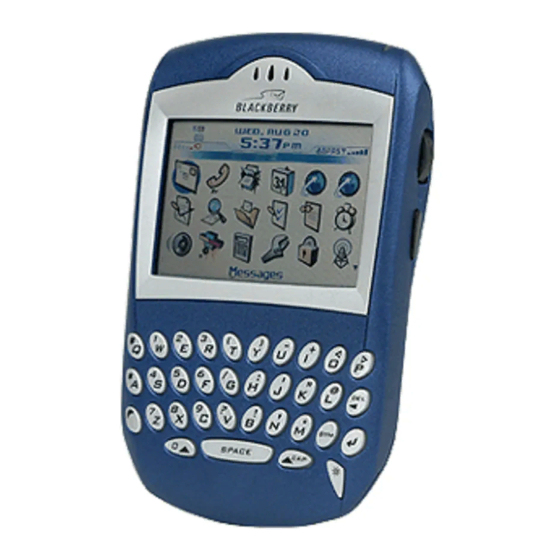- ページ 7
ハンドヘルド Blackberry 7520のPDF 安全性と製品情報をオンラインで閲覧またはダウンロードできます。Blackberry 7520 10 ページ。 Blackberry 7510/7520 from nextel
Blackberry 7520 にも: 交換マニュアル (2 ページ), スタートマニュアル (12 ページ), スタートマニュアル (27 ページ), ユーザーマニュアル (14 ページ)

Before a wireless device model is available for sale to the public, it must be tested and certified to the FCC and IC that
it does not exceed the limit established by the government-adopted requirement for safe exposure under the
recommendations of the International Commission on Non-Ionizing Radiation Protection (ICNIRP). The tests are
performed in positions and locations (for example, at the ear and worn on the body) as required by the FCC and IC for
each model.
The highest SAR values for each device model when tested for use at the ear is outlined below:
BlackBerry 7520™
The highest SAR values for each device model when worn on the body, in an approved holster or carrying case, is
outlined below:
BlackBerry 7520™
Body-worn measurements differ among wireless device and phone models, depending upon available accessories and
FCC and IC requirements. While there may be differences between the SAR levels of various wireless devices and at
various positions, they all meet the government requirement for safe exposure.
The FCC has granted an Equipment Authorization for this wireless device model with all reported SAR levels evaluated
as in compliance with the FCC RF emission guidelines. SAR information on this wireless device model is on file with the
FCC and can be found under the Display Grant section of http:// www.fcc.gov/oet/fccid after searching on FCC ID
L6ARAL11IN. Additional information on Specific Absorption Rates (SAR) can be found on the Cellular
Telecommunications & Internet Association (CTIA) web-site at http://www.wow-com.com.
___________________________________
* In the United States and Canada, the SAR limit for mobile devices used by the public is 1.6 watts/kg (W/kg)
averaged over one gram of tissue for the body or head (4.0 W/kg averaged over 10 grams of tissue for the extremities
- hands, wrists, ankles and feet). The standard incorporates a substantial margin of safety to give additional protection
for the public and to account for any variations in measurements.
The long-term characteristics or the possible physiological effects of Radio Frequency Electromagnetic fields have not
been evaluated by Underwriters Laboratories Inc. (UL).
FCC compliance statement (USA)
FCC Class B Part 15
This device complies with Part 15 of the FCC Rules. Operation is subject to the following two conditions:
• This device may not cause harmful interference, and
• This device must accept any interference received, including interference that may cause undesired operation.
Warning: Changes or modifications to this unit not expressly approved by the party responsible for
compliance could void the user's authority to operate this equipment.
This equipment has been tested and found to comply with the limits for a Class B digital device, pursuant to Part 15 of
the FCC Rules. These limits are designed to provide reasonable protection against harmful interference in a residential
installation. This equipment generates, uses and can radiate radio frequency energy and, if not installed and used in
accordance with the manufacturer's instructions, may cause interference harmful to radio communications.
There is no guarantee, however, that interference will not occur in a particular installation. If this equipment does cause
harmful interference to radio or television reception, which can be determined by turning the equipment off and on, the
user is encouraged to try to correct the interference by one or more of the following measures:
Device
Device
Safety and Product Information Booklet
1 g SAR (W/kg)
1 g SAR (W/kg)
0.77
0.79
7
